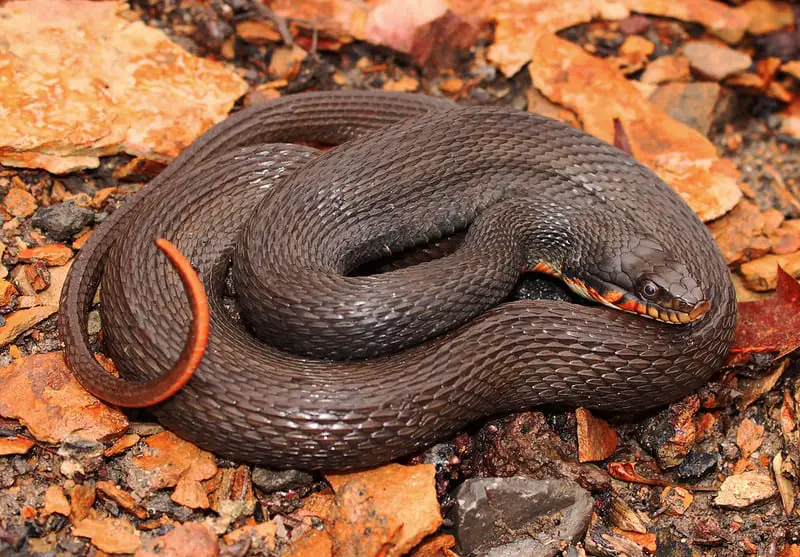The plain-bellied watersnake is a nonvenomous snake most commonly found in or near water in the Southeastern United States. It is usually uniformely colored in black, dark brown or grey with a plain-colored yellow, orange or red belly.
Description
The plain-bellied water snake is most commonly uniformly dark colored with a lighter, plain-colored belly. The back can be dark brown, olive-green or completely black. Younger specimen often show outlines of patterns while adults are completely uniformely colored. The belly is always a light color without any patterns. This fact has earned the snake its common name, the plain-bellied snake. Their plain-colored belly is also the best way to distinguish them from similar-looking dark specimen of the common water snake, which has black crescent-shaped patterns on its belly.

The belly can be cream-colored, white, yellow, orange or even red. Juvenile snakes can be mistaken for a ring-necked snake due to their colored belly.

Size
An adult plain-bellied watersnake reaches a total length of 28-48 inches (70-122 cm). The largest ever recorded specimen was a female with a length of 62 inches (157 cm).

Diet an Habitat
The plain-bellied watersnake is almost always found near a source of water. This can be either reivers, creeks, lakes or swamps and marshlands. The snake is an excellent swimmer and feeds on fish, reptiles and small mammals. Compared to other water snakes, this species spends a lot of time outside of water basking in the sun or even climbing on trees.
Bite
The plain-bellied watersnake is a non-venomous snake species harmless for humans. Its first response to a threat is usually an attempted escape over land. If the snake is handled, it doesn’t hesitate to bite. It will also release a foul smelling substance from its anal vent. Since the saliva of the snake contains an anti coagulant, a bite can cause some intense bleeding. However. due to the size of the snakes teeth, bite marks are genereally small and not a medical concern for humans.
Geographic range
The plain-bellied water snake occurs in the Southeastern United States in Maryland, Texas, Oklahoma, Kansas, Louisiana, Arkansas, Missouri, Mississippi, Alabama, Georgia, South Carolina, Illinois, Indiana, Ohio, Delaware, Eastern North Carolina, Northern Florida, Southern Michigan and Southeastern Iowa.

Subspecies of the plan-bellied water snake
Historically, six subspecies of Nerodia erythrogaster were distinguished. Since 2010, this calssification has been revoked and there are currently no valid subspecies. However, these old terms are still commonly used. Especially the copperbelly water snake (Nerodia erythrogaster neglecta) is still often named as a valid subspecies by various sources. The formerly recognized subspecies are:
- Nerodia erythrogaster alta – plainbelly water snake
- Nerodia erythrogaster bogerti – Bogert’s water snake
- Nerodia erythrogaster erythrogaster – redbelly water snake
- Nerodia erythrogaster flavigaster – yellowbelly water snake
- Nerodia erythrogaster neglecta – copperbelly water snake
- Nerodia erythrogaster transversa – blotched water snake
Scientific classification of Nerodia erythrogaster
- Kingdom: Animalia
- Phylum: Chordata
- Class: Reptilia
- Order: Squamata
- Suborder: Serpentes
- Family: Colubridae
- Genus: Nerodia
- Species: Nerodia erythrogaster
